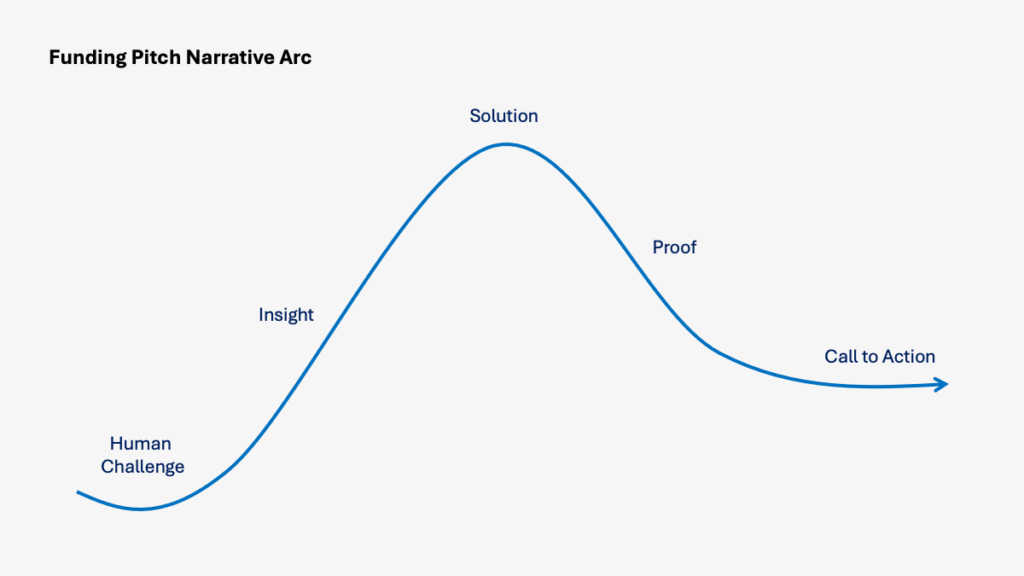Turning Data into Dollars: Crafting Data-Driven Stories That Secure Buy-In and Funding
How many presentations have you seen in your lifetime that are nothing more than glorified reports? Don’t get me wrong, reporting has its place. But data alone doesn’t trigger excitement and spark action. Storytelling does.
The same goes for the dreaded internal pitch. The most successful ones to leadership don’t just present numbers; they weave those numbers into a narrative that’s clear, credible, and compelling. Data-driven storytelling can transform stakeholder doubt into avid support. And, most importantly: funding for your next endeavor. Let’s see how you can go from customer problem, to business solution, to beautifully packaged story that will transform your budgetary ask into a no-brainer.
1. Start with the problem, not the process.
Before diving into data, define the challenge in human terms. Ask questions like:
- What’s broken or underperforming?
- Who is affected, and how?
- Why does this matter now?
Use qualitative insights like customer feedback or stakeholder interviews to frame the issue around real customer pain points, making the problem relatable and urgent for your organization to solve.
2. Use data to validate the pain — and the potential.
Once the problem is clear, validate it with more specific research. Use tools like industry reports, panel research articles, internal analytics dashboards, or financial data to gather baseline insights for a mix of industry trends and internal performance data.
As solutions to the customer problem take shape, field-test your ideas with a short, targeted survey to test their viability. It’s hard to deny the project you pitched is a good investment when you’re hearing it straight from potential customers.
While this triangulation builds credibility and shows you’ve done your homework, it also quantifies the opportunity, prioritizes solutions based on the demand of real customers, and demonstrates alignment with business goals your finance team already knows well.
By strategically layering data throughout the narrative, recommendations feel imperative — not optional.
3. Build a narrative arc that leads to “yes.”
There’s nothing worse than a deck that comes together like Frankenstein’s Monster. It’s alive! But … is it? Rather than cramming your disparate ideas into a loosely organized report, structure your presentation like a story:
- Start with the hook in the form of a question or challenge: What’s the pain point?
- Next, introduce the insight: What unique or novel point does the data reveal? Begin to set up how you’re uniquely positioned to solve it.
- Follow with the solution: What are you proposing the business do about it?
- Then offer proof: Why — and how — will it work? What will success look like?
- Finally, ask: What is your call to action? Be specific.

This format keeps leadership focused on the problem at hand and helps them follow your logic to see the value clearly.
4. Package it for impact.
Your story needs to be as polished as it is persuasive. Consider:
- A concise, visually engaging presentation deck enhanced by *real* designers
- A short video or animation to generate excitement
- A one-pager or executive summary for quick reference
Tailor your materials to each audience you need on board. What works for a finance panel may differ from what resonates with practice leaders, product owners, or marketing.
Data Is the Spark, Not the Flame
Data is powerful, but it’s not persuasive on its own. To gain buy-in and funding, you need to turn data into a powerful story that is moving for stakeholders and resonates with both the head and the heart. When you do, you don’t just get buy-in, you get believers.
Need help pitching your ideas to those who hold the purse strings? One North can research and diagnose the challenge, mine data from leading panel companies, shape a compelling story, and execute a beautifully designed pitch.
Photo Credit: Anna Vaschenko
Erica Thomas
Erica is a Senior Brand Strategist at One North. She works with clients and other cross-disciplinary strategists to mine information, develop insights, and create stellar branding and marketing strategies that support business goals. Erica brings her unrelenting curiosity to everything she does, from political docuseries to target audience research. She graduated from Aurora University with a bachelor’s in Psychology and a minor in Marketing.
